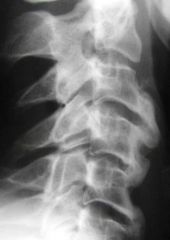![]()
![]()
![]()
Use LEFT and RIGHT arrow keys to navigate between flashcards;
Use UP and DOWN arrow keys to flip the card;
H to show hint;
A reads text to speech;
14 Cards in this Set
- Front
- Back
|
What are the other two names DISH is called?
|
1. Senile Ankylosing Hyperostosis
2. Forrestier's Disease |
|
|
What is the definition of DISH?
|

Ligamentous calcification and ossification, especially of the ALL.
|
|
|
5-10% of people with DISH are greater than what age?
|
65 years old
|
|
|
Women are susciptable to DISH more than men. True or False?
|
False. Men are more susciptable than women.
|
|
|
What is the etiology of DISH?
|
Uknown
|
|
|
When DISH occurs, in what part of the vertebra does it begin, and where does it end?
|
It begins in the mid-vertebral body, and it bridges the disc space, initially within the deep ALL fibers.
|
|
|
What clinical findings would be present?
|
Morning stiffness, mild to moderate musculoskeletal pain in the spine.
|
|
|
Another clinical finding common in about 20% of people with DISH would be what?
|
Dysphagia - because the calcified ALL puts pressure on the pharynx.
|
|
|
Where is DISH most commonly found within the body?
|
The thoracic spine between T7 and T11.
It is also found in the cervical region from C4 to C7. Can also be found in L1-L3 |
|
|
What percentage of patients with DISH have ossification of the PLL?
|
50%
|
|
|
When looking at an X-Ray, what would you find in a patient with DISH?
|
Flowing calcification and ossification of the anterior aspect of the vertebra across at least four vertebral bodies.
|
|
|
In a patient with DISH, the disc space is greatly reduced. True or False?
|
False. There is a preservation of the disc space, unlike DJD.
|
|
|
In a patient with DISH, there is no ankylosis in the apophyseal and SI joints. True or False?
|
True. The apophyseal and SI joints remain mobile.
|
|
|
13-32% of patients with DISH have what pre-existing pathology?
|
Diabetes
|

